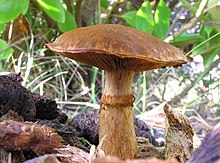
An annulus is the ring-like or collar-like structure sometimes found on the stipe of some species of mushrooms. The annulus represents the remnants of the partial veil, after it has ruptured to expose the gills or other spore-producing surface. It can also be called a ring which is what the Latin word annulus directly translates as. The modern usage of the Latin word originates from the early days of botany and mycology when species descriptions were only written in Latin. Outside of the formal setting of scientific publications which still have a Latin requirement, it will often just be referred to as a ring or stem ring in field guides and on identification websites.
Ring descriptions
The way in which the structure and appearance of rings is described can vary with author and the description may only note the existence of a ring without providing specific information in cases where the ring lacks any notable features that would be useful to distinguish between similar species. Ring shapes and structures can also vary between specimens of the same species and change with the age of the mushroom so multiple descriptions are sometimes used. Even in species with distinctly identifiable rings they may not always be present or perfectly match descriptions so it can be beneficial to have multiple specimens to compare at different states of maturity.
Some rings may be persistent and remain through the life of the mushroom or they may disappear with age. Such rings have a variety of synonymous terms associated with them such as fleeting, ephemeral, evanescent, transient, fugacious or impermanent. These rings may peel away from the stem, fall apart or simply fade into the stem surface as it matures. Rings may also be described as fragile, meaning easily torn or damaged and whilst some fragile rings could be considered permanent if undisturbed they are often likely to vanish due to their fragility. Some rings may be fixed in place and firmly attached to the stem whilst others may be movable or mobile with the ability to slide up and down the stem either by hand or just falling down naturally with age. Fragile and movable rings can appear to vanish so examining the stem for traces of a ring zone (or annular zone) or the base for a detached ring can sometimes be helpful. Various combinations of these terms can be used to best describe the nature of the ring in a particular species.
Some common descriptions of the type of ring include:
- Ringless - a stem which has no ring.
- Double - a ring with a distinct upper and lower surface.
- Flaring - a ring which flairs upwards and away from the stem, sometimes also called ascending.
- Pendant - a hanging or skirt like partial veil.
- Peronate - a sheathed stem which may resemble a stocking that covers the full length.
- Cortinate - a fibrous, cobweb like cortina, especially notable in some Cortinarius species.
- Ring zone - an area on the stem where only traces of the ring remain, sometimes becoming visible due to spore staining.
-
 Ringless stem of Amanita vaginata
Ringless stem of Amanita vaginata
-
 Double ring of Chlorophyllum rhacodes
Double ring of Chlorophyllum rhacodes
-
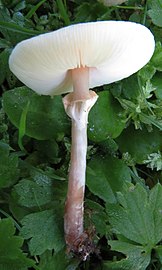 Flaring stem ring
Flaring stem ring
-
 Pendant veil of Amanita bisporigera
Pendant veil of Amanita bisporigera
-
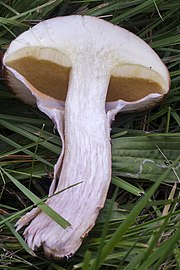 Peronate or sheathed stem of Suillus luteus (cross section)
Peronate or sheathed stem of Suillus luteus (cross section)
-
 Cortina of a Cortinarius species
Cortina of a Cortinarius species
-
 Ring zone of Cortinarius archeri stained by spores
Ring zone of Cortinarius archeri stained by spores
Texture/Flesh
The texture of the partial veil can exhibit specific characteristics which can aid in identification and these may persist in the ring once the cap has detached from it. These details may be similar to that of the cap surface or distinct from it.
Texture/surface descriptions include:
- Thick - a ring with thick, often sturdy flesh.
- Membranous - a thin fleshed, often diminutive ring.
- Stellate - a star or cogwheel shaped veil.
- Floccose - a woolly or scaly veil, often resembling the texture of the cap.
-
 Thick ring of a Chlorophyllum species
Thick ring of a Chlorophyllum species
-
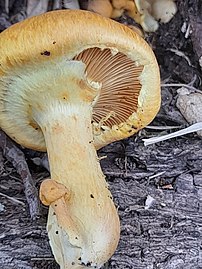 Membranous partial veil of Gymnopilus junonius
Membranous partial veil of Gymnopilus junonius
-
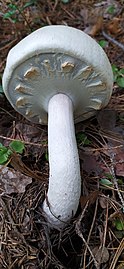 Stellate or cogweel veil on an Agaricus species
Stellate or cogweel veil on an Agaricus species
-
 Floccose veil on an Amanita species
Floccose veil on an Amanita species
Ring positions
The position of the ring can be an important factor to observe to aid in identification although it is often not included in descriptions as for some species it can be quite variable. The position may appear different from specimen to specimen due to the height of the stem or the age of the mushroom and in species with movable, fragile or otherwise detachable rings it may not always be a reliable factor to observe. However for species which otherwise look quite similar but exhibit differences in colouration, texture or staining above or below the stem ring, the position can be a useful factor to note.
The common descriptions of positions are:
- Superior - Near the top of the stem.
- Apical - Above the middle of the stem.
- Median - In the middle of the stem.
- Inferior - Below the middle of the stem.
- Basal - Near the base of the stem.
-
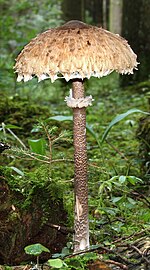 Superior, double ring of a Macrolepiota species
Superior, double ring of a Macrolepiota species
-
 Inferior, flared ring of a Leucocoprinus species
Inferior, flared ring of a Leucocoprinus species
See also
References
- "annulus", Wiktionary, 2022-08-03, retrieved 2022-08-05
- Figueiredo, Estrela; Moore, Gerry; Smith, Gideon F. (April 2010). "Latin diagnosis: Time to let go". Taxon. 59 (2): 617–620. doi:10.1002/tax.592027. hdl:2263/16700. ISSN 0040-0262.
- Buczacki, Stefan (2012). Collins fungi guide. London: Collins. ISBN 978-0-00-724290-0. OCLC 793683235.
- ^ Kuo, Michael (2019). "Glossary (MushroomExpert.Com)". www.mushroomexpert.com. Retrieved 2022-08-05.
- "Neolentinus lepideus, Train Wrecker fungus". www.first-nature.com. Retrieved 2022-08-06.
- "evanescent". www.mushroomthejournal.com. Retrieved 2022-08-06.
- "Protostropharia (Stropharia) semiglobata, Dung Roundhead". www.first-nature.com. Retrieved 2022-08-06.
- Szczepkowski, Andrzej; Gierczyk, Błażej; Kujawa, Anna; Dobrzyński, Piotr (2022-05-08). "Macrofungal diversity of greenhouses at the Warsaw University Botanic Garden". Ecological Questions. 33 (2): 95–100. doi:10.12775/eq.2022.018. ISSN 1644-7298. S2CID 249724619.
- ^ "Glossary". biolwww.usask.ca. Retrieved 2022-08-06.
- Kuo, Michael (2019). "Glossary (MushroomExpert.Com) - Ring Zone". www.mushroomexpert.com. Retrieved 2022-08-06.
- "annular zone", Wiktionary, 2016-07-25, retrieved 2022-08-06
- ^ "Mushroom Veils & Annulus (ring) | Mushroom Identification". mycologyst.art. Retrieved 2022-08-05.